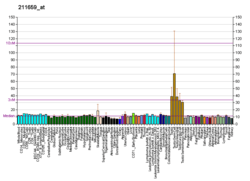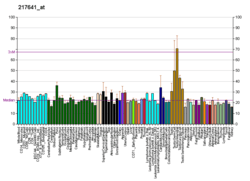GPR135
Probable G-protein coupled receptor 135 is a protein that in humans is encoded by the GPR135 gene.[5][6]
| GPR135 | |||||||||||||||||||||||||
|---|---|---|---|---|---|---|---|---|---|---|---|---|---|---|---|---|---|---|---|---|---|---|---|---|---|
| Identifiers | |||||||||||||||||||||||||
| Aliases | GPR135, HUMNPIIY20, G protein-coupled receptor 135 | ||||||||||||||||||||||||
| External IDs | OMIM: 607970 MGI: 2676315 HomoloGene: 11211 GeneCards: GPR135 | ||||||||||||||||||||||||
| |||||||||||||||||||||||||
| |||||||||||||||||||||||||
| |||||||||||||||||||||||||
| |||||||||||||||||||||||||
| Orthologs | |||||||||||||||||||||||||
| Species | Human | Mouse | |||||||||||||||||||||||
| Entrez | |||||||||||||||||||||||||
| Ensembl | |||||||||||||||||||||||||
| UniProt | |||||||||||||||||||||||||
| RefSeq (mRNA) | |||||||||||||||||||||||||
| RefSeq (protein) | |||||||||||||||||||||||||
| Location (UCSC) | Chr 14: 59.43 – 59.47 Mb | Chr 12: 72.07 – 72.07 Mb | |||||||||||||||||||||||
| PubMed search | [3] | [4] | |||||||||||||||||||||||
| Wikidata | |||||||||||||||||||||||||
| |||||||||||||||||||||||||
References
- GRCh38: Ensembl release 89: ENSG00000181619 - Ensembl, May 2017
- GRCm38: Ensembl release 89: ENSMUSG00000043398 - Ensembl, May 2017
- "Human PubMed Reference:". National Center for Biotechnology Information, U.S. National Library of Medicine.
- "Mouse PubMed Reference:". National Center for Biotechnology Information, U.S. National Library of Medicine.
- Fredriksson R, Hoglund PJ, Gloriam DE, Lagerstrom MC, Schioth HB (Nov 2003). "Seven evolutionarily conserved human rhodopsin G protein-coupled receptors lacking close relatives". FEBS Lett. 554 (3): 381–8. doi:10.1016/S0014-5793(03)01196-7. PMID 14623098.
- "Entrez Gene: GPR135 G protein-coupled receptor 135".
Further reading
- Kunz D, Gerard NP, Gerard C (1992). "The human leukocyte platelet-activating factor receptor. cDNA cloning, cell surface expression, and construction of a novel epitope-bearing analog". J. Biol. Chem. 267 (13): 9101–6. PMID 1374385.
- Strausberg RL, Feingold EA, Grouse LH, et al. (2003). "Generation and initial analysis of more than 15,000 full-length human and mouse cDNA sequences". Proc. Natl. Acad. Sci. U.S.A. 99 (26): 16899–903. doi:10.1073/pnas.242603899. PMC 139241. PMID 12477932.
- Vassilatis DK, Hohmann JG, Zeng H, et al. (2003). "The G protein-coupled receptor repertoires of human and mouse". Proc. Natl. Acad. Sci. U.S.A. 100 (8): 4903–8. doi:10.1073/pnas.0230374100. PMC 153653. PMID 12679517.
- Vanti WB, Nguyen T, Cheng R, et al. (2003). "Novel human G-protein-coupled receptors". Biochem. Biophys. Res. Commun. 305 (1): 67–71. doi:10.1016/S0006-291X(03)00709-5. PMID 12732197.
- Gerhard DS, Wagner L, Feingold EA, et al. (2004). "The status, quality, and expansion of the NIH full-length cDNA project: the Mammalian Gene Collection (MGC)". Genome Res. 14 (10B): 2121–7. doi:10.1101/gr.2596504. PMC 528928. PMID 15489334.
This article is issued from Wikipedia. The text is licensed under Creative Commons - Attribution - Sharealike. Additional terms may apply for the media files.






